NxaaS In Action: Regional Healthcare System Empowers Nurses with Instant Medical Device Support
Part 3 of our NXaaS series exploring real-world implementations
It’s 2:47 AM in the cardiac wing of Riverside Regional Medical Center. Nurse Sarah Martinez is monitoring a post-surgical patient when the telemetry monitor starts showing intermittent connection drops. The patient’s vitals are stable, but the wireless signal keeps cutting out, triggering false alarms that wake other patients and stress the nursing staff.
In the old system, Sarah would have to page IT, wait for a callback, then either troubleshoot over the phone or wait for a technician to arrive. With a critical patient, every minute matters, not just for medical reasons, but for the cascade of disruptions that follow when essential monitoring equipment fails.
This scenario plays out hundreds of times daily across healthcare systems. Medical devices are increasingly networked, from IV pumps and patient monitors to mobile workstations and diagnostic equipment. When connectivity fails, patient care suffers, and clinical staff lose precious time to technical troubleshooting they weren’t trained for.
The Critical Challenge
Riverside Regional serves a population of 400,000 across three hospital campuses and twelve outpatient facilities. Their device inventory includes over 8,000 networked medical devices: patient monitors, infusion pumps, ventilators, mobile diagnostic equipment, and wireless workstations that nurses use for charting and medication administration.
The challenge wasn’t device reliability, as these are enterprise-grade medical systems. The problem was network complexity. Healthcare facilities are notoriously difficult wireless environments: concrete and steel construction, electromagnetic interference from medical equipment, high device density, and strict security requirements that segment medical networks from general IT infrastructure.
When devices lost connectivity, the impact rippled through patient care:
False alarms from monitoring equipment created alert fatigue
Delayed medication administration when mobile carts couldn’t access pharmacy systems
Interrupted procedures when surgical equipment lost network connectivity
Documentation gaps when nurses couldn’t access electronic health records
The existing support model couldn’t scale. IT staff couldn’t be physically present in every clinical area 24/7, and nurses didn’t have the technical background to diagnose network issues while managing patient care responsibilities.
Voice-Activated Clinical Support
Riverside deployed NXaaS with a hands-free, voice-activated interface designed specifically for clinical environments. Nurses can now speak to wall-mounted devices or wear wireless earpieces to get instant technical support without interrupting patient care.
Here’s how it works in practice:
Nurse Sarah (speaking to wall unit): “Telemetry monitor in room 314 keeps dropping connection”
NXaaS (audio response): “Room 314 monitor is connected to MedNet-5G. Signal strength is marginal at -82 dBm. I’m switching it to the backup access point. Connection restored. The issue was interference from the new MRI suite. I’m logging this for infrastructure review.”
Behind this 15-second interaction, NXaaS coordinated multiple systems:
Device management APIs identified the specific monitor and its current network configuration
Medical network APIs analyzed signal strength, bandwidth, and interference patterns
Location services correlated the room position with nearby access points and potential interference sources
Asset management systems verified device credentials and security certificates
Incident tracking automatically logged the issue for trend analysis and infrastructure planning
Beyond Connectivity: Intelligent Medical Device Management
The system evolved beyond basic network troubleshooting to become an intelligent layer between clinical staff and complex medical technology:
The AI doesn’t just solve problems—it prevents them. By analyzing usage patterns, device performance metrics, and environmental factors, NXaaS can predict connectivity issues before they impact patient care.
The Healthcare-Specific Architecture
Implementing NXaaS in healthcare required addressing unique regulatory and operational requirements:
HIPAA Compliance: All communications are encrypted and logged. The system accesses device and network data without storing patient health information. Voice interactions are processed locally and not transmitted to external AI services.
Medical Device Integration: Healthcare APIs connect to device management platforms from major manufacturers—Philips, GE Healthcare, Medtronic, and others. This provides real-time status monitoring for everything from bedside monitors to surgical robotics.
Clinical Workflow Integration: The system interfaces with electronic health record (EHR) systems, pharmacy management platforms, and nursing documentation tools to understand the clinical context of technical issues.
Redundant Infrastructure: Medical-grade network requirements mean multiple backup systems, isolated VLANs for critical devices, and failover mechanisms that ensure patient monitoring never stops, even during network maintenance.
Role-Based Access: Different clinical roles have different technical needs. Nurses get device-specific troubleshooting, while biomedical technicians receive detailed diagnostic data for equipment maintenance.
Measurable Impact on Patient Care
Six months after deployment, Riverside Regional documented significant improvements across clinical operations:
Device Connectivity Issues:
Before NXaaS: 2,847 device connectivity tickets per month
After NXaaS: 623 tickets requiring human IT intervention (78% reduction)
Average resolution time: From 23 minutes to 90 seconds
Clinical Workflow Efficiency:
Nursing documentation delays: Reduced by 34%
Medication administration delays: Reduced by 41%
False alarm events: Reduced by 52%
Staff Satisfaction:
Nurse satisfaction with IT support: Improved from 2.1/5 to 4.7/5
IT staff job satisfaction: Increased as they shifted from reactive troubleshooting to proactive infrastructure improvement
Patient Care Metrics:
Patient fall incidents: Decreased by 18% (attributed to more reliable nurse call systems and monitoring)
Medication error rate: Reduced by 12% (due to improved pharmacy system connectivity)
Clinical Lessons and Best Practices
Riverside’s implementation revealed key insights for healthcare IT:
Clinical context matters more than technical detail. Nurses don’t need to understand network protocols—they need to know if the problem is fixed and how long it will take.
Hands-free operation is essential. In clinical environments, staff often can’t stop patient care activities to troubleshoot devices. Voice interfaces and automated problem resolution are critical.
Predictive intelligence prevents crises. By identifying patterns in device connectivity, NXaaS helps prevent equipment failures during critical procedures like surgery or emergency response.
Integration beats isolation. The most powerful implementations connect device management, network infrastructure, and clinical workflow systems to provide holistic solutions rather than point fixes.
Trust builds gradually. Clinical staff initially used NXaaS for simple issues while still calling IT for complex problems. As confidence grew, adoption expanded to more critical situations.
The Ripple Effect
The success at Riverside Regional has sparked broader transformation. The system now helps with:
Equipment lifecycle management: Predicting when devices need maintenance or replacement based on connectivity patterns and performance degradation.
Clinical resource optimization: Analyzing device usage patterns to improve equipment allocation and reduce wait times for diagnostic procedures.
Emergency preparedness: Ensuring critical care equipment maintains connectivity during power outages, network maintenance, or disaster response scenarios.
Regulatory compliance: Automated logging and reporting for Joint Commission requirements and FDA medical device regulations.
Looking Forward
Healthcare represents one of the most complex environments for network infrastructure, but also one with the highest stakes. When technology works seamlessly, clinical staff can focus entirely on patient care. When it fails, the consequences affect human lives.
NXaaS is evolving toward even more sophisticated healthcare applications: integration with surgical robotics, real-time monitoring of implantable devices, and AI-assisted diagnostics that require reliable, high-bandwidth connectivity.
The goal remains the same: making complex technology invisible to the humans who depend on it, so they can focus on what matters most—caring for patients.



